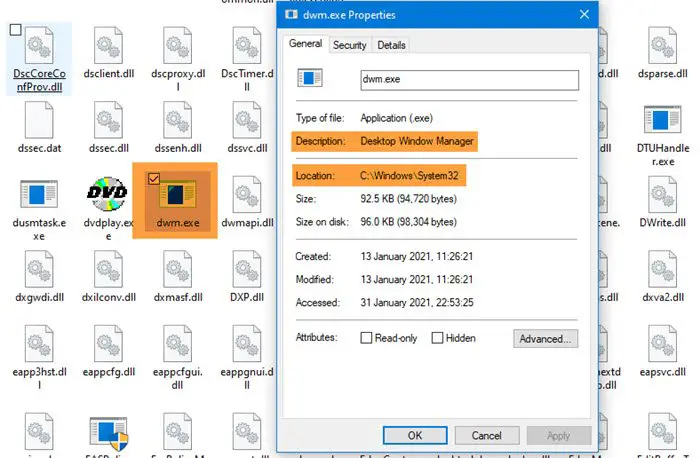Some users have seen an error message on their Windows system stating – Desktop window manager stopped working and was closed. According to the users, this issue arises while performing specific tasks like playing a video, or while running a program, or even while doing any task related to Windows Explorer. The common reasons include:
Incorrect/failed installation or uninstallation of software that can lead to invalid entries in your Windows registryConsequences of a virus or malware attackImproper system shutdown due to a power failureCorrupted system files.
Desktop Window Manager stopped working and was closed
Try one of the solutions: Let us look at these solutions in more detail.
1] Run an SFC scan
Maybe the system file has become damaged. You can repair the damaged files by running the System File Checker tool. To run a complete SFC scan, follow these steps: 1] Click on Windows ‘Start’ and type ‘cmd’ 2] Now, right-click on ‘Command Prompt’ and hit ‘Run as Administrator’ 3] In the ‘Command Prompt’ window, type ‘sfc/scannow’ 4] Hit ‘Enter’ Wait for the System File Checker tool to complete the process.
2] Run an Antivirus Scan
Occasionally the problem could be caused because of a malicious attack as well. In such a case, a thorough antivirus scan using reliable antivirus software can find and fix the problem.
3] Run ChkDsk
Checking your hard disk, every once in a while, for errors – usually caused due to improper or sudden shutdowns, corrupted software, metadata corruption, etc., – in Windows is always a good practice as this can help solve some computer problems and improve the performance of your Windows computer. Sometimes bad sectors in your hard disks can stop Desktop Windows Manager from working properly. Read: Program exe or COM Surrogate has stopped working.
4] Try rotating the second screen
A few users reported that this issue occurred when they changed the second screen rotation to portrait mode. Hence if you are using 2 monitors and you attempted to change some settings in your graphics card i.e., rotating the 2nd screen, then try putting the screen back to the landscape mode. Once you’ve put the monitor back to the normal mode, restart the system and check if the issue persists.
5] Update or Rollback Graphics card driver
Update your Graphics driver and see if it helps. If you recently updated your Graphics driver and then this problem started, then we suggest that you rollback the driver.
To update the driver:
1] Press ‘Win + R’ keys to open the ‘Run’ dialog box. 2] In the ‘Run’ dialog, type ‘devmgmt.msc’
3] Hit ‘Enter’ 4] In the ‘Device Manager’ windows locate ‘Display adapters’ and click on the arrow and expand it. 5] Double-click on your graphics card to launch its ‘Properties’ window. 6] In the graphic card ‘Properties’ window, click the ‘Driver’ tab. 7] Under the Driver tab, hit on ‘Update Driver’. 8] You will be prompted for options on ‘How do you want to search for drivers?’ click on ‘Search automatically for drivers’.
Windows will now search for any new updates available for your graphics card driver and install them. Once the process is completed. check if your issue is resolved.
To rollback the driver:
1] Press ‘Win + R’ keys to open the ‘Run’ dialog box. 2] In the ‘Run’ dialog, type ‘devmgmt.msc’
3] Hit ‘Enter’ 4] In the ‘Device Manager’ windows locate ‘Display adapters’ and click on the arrow and expand it. 5] Double-click on your graphics card to launch its ‘Properties’ window. 6] In the graphic card ‘Properties’ window, click the ‘Driver’ tab. 7] On the ‘Driver’ tab there would be a button named ‘Roll Back Driver’. If there are any recent updates installed, then this button would be active. Click on the ‘Roll Back Driver’ button.
Wait for the update to be rolled back, and restart the system and check if the issue persists. If the button is not active, please move on to the next method.
6] Run Hardware and Devices troubleshooter
Run the Hardware and Devices troubleshooter and see if it helps.
7] Troubleshoot in Clean Boot State
Clean Boot is used to diagnose and troubleshoot advanced Windows problems. If your computer is not starting normally, or if you receive errors when you start the computer that you cannot identify, you could consider performing a Clean Boot. A Clean Boot provides booting your Windows with driver/application services; hence it will eliminate deviously if there is a conflict between Desktop Windows Manager and another application.
8] Reset Windows 10
In case your Windows 10 operating system is not performing properly and is, in fact, giving you problems, you may want to consider using the Reset this PC feature that is available in Windows 10. Related read: Desktop Window Manager dwm.exe consumes high CPU or Memory. We hope you could resolve the Desktop Window Manager error with this guide.

